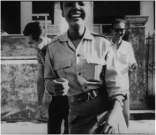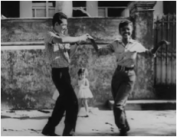My participation in a documentary film course run by the brilliant Barbara Knorpp from UCL, has prompted my own exploration into the 5 documentary films below, all coming from a female perspective.
Although Agnes Varda wasn’t included in the course her first two films below can be linked to Cinema Verite a movement in which fiction and documentary combined for the first time. Jean Rouche’s Chronicles of a Summer (1961) is a much discussed film of this genre where he used filmmaking as a way of eliciting truths and creating situations with the camera as “provocateur.” Varda’s films below are early examples using this experimental, filmmaking style.
L’ Opera Mouffe Agnes Varda (1958) 17 mins
In this short, Agnes Varda films the Parisians in the Rue Mouffetard, ‘le quartier Mouffe’, a busy street market in the then working class district in the heart of Paris. Borrowing from ethnographic filmmaking and the Cinema Verite style of Jean Rouche, the camera ‘explains’ to the viewer the subjects it films. There is a desire to capture how people live their lives and a holding back from any judgement . It has a fresh, child like feel, Varda responding to the world around her with a direct approach. There is no narration just an accordion player and a female voice. It begins with handwritten titles ; ‘a filmed notebook on the rue Mouffetard seen by a pregnant woman in 1958.’ 
This idea of filmmaking as the equivalent of taking notes was one of the ways ethnographers used film to record actions and events that were too complex to capture in words. Agnes Varda is clearly influenced by this, facilitated by 16 mm film and the new lighter weight cameras . Varda was pregnant at the time and she turns the camera on herself, noting the sensations she felt in that peculiar state of mind and body, the opening shot of her naked belly juxtaposed with a pumpkin being sliced in half, seeds gouged out by a knife,is perhaps a commentary on her own mixed feelings towards maternity.
Varda intersperses fictional sequences of two beaming lovers seen undressing and making love, together with documentary visuals of the market; crates of vegetables , women gossiping, people who work, children who play, those who drift, get drunk and sometimes sleep on the street. This film can be seen to be an excellent, early example combining the observational with the personal taken up by so many filmmakers in the decades to come.


Watch here: L’Opera Mouffe
Salut Les Cubains, Agnes Varda (1963) 27 mins
Roughly translated as either Hi or Hail the Cubans, this film is a photographic, musical homage to the Cuban revolution of the 1950’s. Agnes Varda, was invited over by the Cuban film school the Institute of Cuban Cinematic Art and Industry, to initiate a response to their country. The film has undertones of the essay film and has key filmmakers of the time participating, Chris Marker, (who had just finished another political documentary, Cuba Si) Alain Resnais, and Michel Legrand (composer) all cited in the credits.
The film begins at an exhibition of Varda’s photographs of Cuba . The narrator states, ‘Paris 1963, Saint Germain des Pres.’ The viewer looks at the photo’s but then also at the filmmakers who are filming, the Cuban musicians who have we assume, been invited to perform in the streets of Paris to an excited crowd gathering around them. This self reflexivity is part of the early acknowledgement of the power of the camera and the part played by the camera in the creation of meaning, we even see Varda in the crowd, this investigated by Rouche and others at the time.  The seductive Rhumba music transports us out of Paris then into Cuba itself. The film is narrated by actor Michel Piccoli and Varda who provide ironic commentary to the visuals “yes there are beards, yes there are cigars” also serving to inform us about the spirit of the co-operatives, the reconstruction of Cuba built by the people and the film revels in both the ‘picturesque’ and the political, capturing the joy and the energy of a country undergoing a socialist transformation.
The seductive Rhumba music transports us out of Paris then into Cuba itself. The film is narrated by actor Michel Piccoli and Varda who provide ironic commentary to the visuals “yes there are beards, yes there are cigars” also serving to inform us about the spirit of the co-operatives, the reconstruction of Cuba built by the people and the film revels in both the ‘picturesque’ and the political, capturing the joy and the energy of a country undergoing a socialist transformation.  Varda edited the film to a soundtrack of Cuban music, using over 1800 stills, in a rhythmic montage of images celebrating aspects of Cuban life, artists, singers, sugar plantation workers and lots of dancing.The film ends on Sara Gomez a documentary Cuban filmmaker who died when she was only 30, who dances the Cha Cha Cha in the street.
Varda edited the film to a soundtrack of Cuban music, using over 1800 stills, in a rhythmic montage of images celebrating aspects of Cuban life, artists, singers, sugar plantation workers and lots of dancing.The film ends on Sara Gomez a documentary Cuban filmmaker who died when she was only 30, who dances the Cha Cha Cha in the street. 
 Watch here: https://vimeo.com/17217039
Watch here: https://vimeo.com/17217039
Reassemblages, Trin T. Minh- Ha, (1983) 40 mins
A visual study of women in rural Senegal , this film by Vietnamese American feminist theorist and filmmaker is a reflection on documentary filmmaking, she asks “What can we expect from ethnology ?” This question is reconsidered though the filmic process ; camera, editing and narration upsets the premise of ethnographic filmmaking. « What I see is life looking at me . » Narrated by Min Ha, the film asks questions : “A film about what ? A film about Senegal. But what about Senegal “? http://trinhminh-ha.com/films/
Letter From My Village, Safi Faye (1975) 90 mins
Safi Faye, the first sub Saharan African woman to direct a feature film, is now recognised as one of their most prominent directors. Narrated in the form of a letter, between an exiled Senegalese student and his mother and shot in 16 mm in the fictional documentary style of Cinema Verite, it describes life in Faye’s native Senegalese village. Many of Faye’s films are political, focussing on the economic problems affecting people. This film describes the outdated colonial system of planting ground nuts as a main crop to sell to the world market and the impact on the villagers this has. The narrative follows Ngor a young man who is unable to pay for his bride and who goes to seek his fortune in the city. A tale of corruption and exploitation, the film was critical of the Senegalese government and was banned from public viewing as have many of her films. http://www.bfi.org.uk/films-tv-people/4ce2b733464a0
The Punk Singer, Sini Anderson (2013) 80 mins
Centred on Kathleen Hannah, lead singer of Bikini Kill a riot grrrl band of the 1990’s, the film documents Hannah’s involvement in the US punk scene and includes archive footage, present day interviews and chronologically retraces her life. In terms of form there is nothing experimental about this film, but it is the content and the music that provides the interest . It records a heady, brief moment when feminism was entwined with popular culture with young women railing against the male dominated music industry. Watched on Film4.



